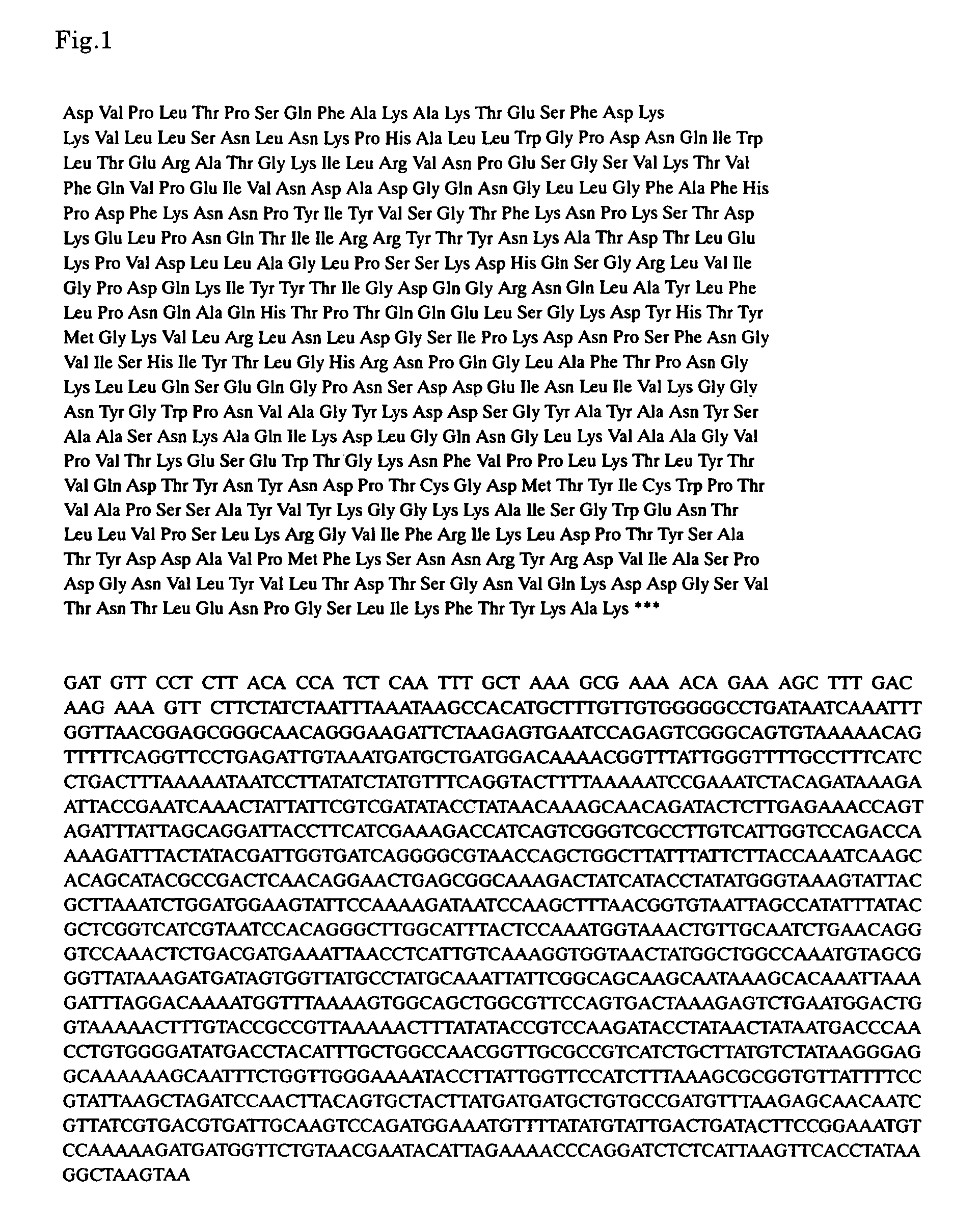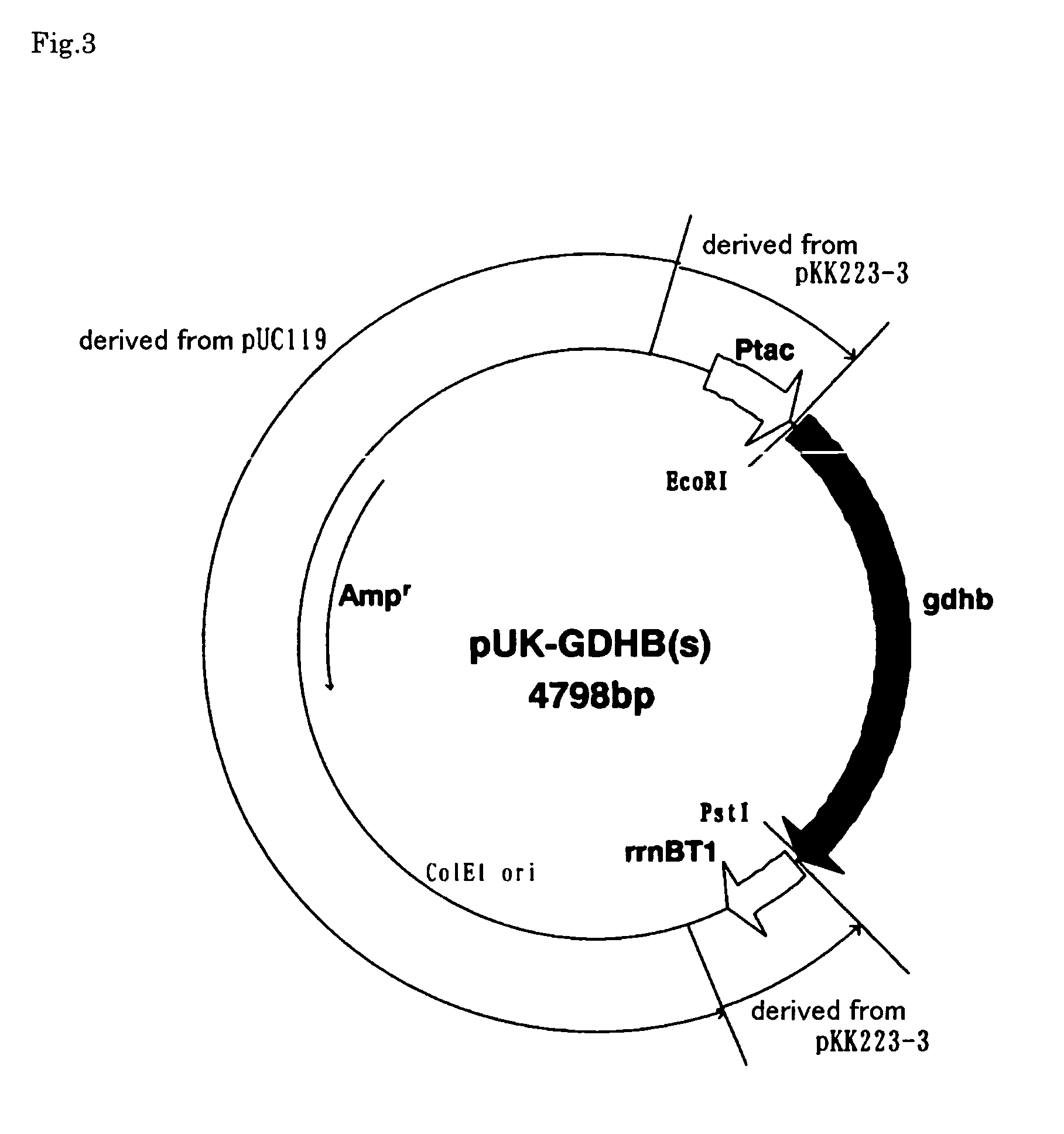Pyrroloquinoline quinone-dependent glucose dehydrogenase
a glucose dehydrogenase and pyrroloquinoline technology, applied in the field of pyrroloquinoline quinone-dependent glucose dehydrogenase, can solve the problems of inability to determine the exact amount of glucose in blood, inability to carry out reliable measurement, and inability to find pqqgdh with sufficiently low reactivity with respect to galactose, etc., to achieve low reactivity, low reactivity, and high substrate specifi
- Summary
- Abstract
- Description
- Claims
- Application Information
AI Technical Summary
Benefits of technology
Problems solved by technology
Method used
Image
Examples
example 1
Isolation of Chromosomal DNA
[0106]Chromosomal DNA of Acinetobacter calcoaceticus IFO 12552 strain was isolated by the following method. This strain was cultured in 10 mL of LB medium with shaking at 30° C. over night, and then centrifuged (at 15000 rpm for 10 minutes) so as to collect bacteria. From the collected bacteria, chromosomal DNA was extracted and purified by using a Dneasy tissue kit (QIAGEN K.K.) and dissolved in a TE buffer.
example 2
Preparation of DNA Fragment Containing Gene Encoding PQQGDH, and Construction of Recombinant Vector Containing DNA Fragment
[0107]The chromosomal DNA obtained in Example 1 was used as a template to amplify a region of DNA including the targeted PQQGDH gene by polymerase chain reaction (PCR) using the following primers. Note here that the primers to be used herein were designed based on a base sequence of soluble PQQGDH (A-M Cleton-Jansen et al., Gen. Genet., 217, 430 (1989)) derived from Acinetobacter species L.M.D 79.41 strain.
[0108]Forward Primer:[0109]5′-ACAAATCATATAGAGAACTCG-3′ (SEQ ID NO: 5)
[0110]Reverse Primer:[0111]5′-TTACTTAGCCTTATAGGTGAACTTAATGAGAGATCCTGGG-3′ (SEQ ID NO: 6)
[0112]The PCR was carried out in a solution having the composition shown in Table 1 under conditions of carrying out a reaction at 94° C. for 2 minutes, then 30 cycles of reactions at 94° C. for 30 seconds, at 48° C. for 30 seconds and at 72° C. for 2 minutes, and finally a reaction at 72° C. for 10 minute...
example 3
Determination of Sequence List of Soluble PQQGDH of Acinetobacter calcoaceticus IFO 12552 Strain
[0115]The sequence of the gene fragment inserted into the plasmid pTGEM-GDHB obtained in Example 2 was determined by the use of BigDye Terminator Sequencing Kit (Applied Biosystems Japan Ltd.). The determined base sequence and amino acid sequence are shown in SEQ ID NO: 2 and SEQ ID NO: 1, respectively. Note here that base sequence and amino acid sequence including the signal regions are shown in SEQ ID NO: 4 and SEQ ID NO: 3, respectively. The molecular weight of protein calculated from the amino acid sequence was about 50,000 which was substantially identical with the molecular weight of soluble PQQGDH of Acinetobacter calcoaceticus.
PUM
| Property | Measurement | Unit |
|---|---|---|
| temperature | aaaaa | aaaaa |
| pH | aaaaa | aaaaa |
| pH | aaaaa | aaaaa |
Abstract
Description
Claims
Application Information
 Login to View More
Login to View More - R&D
- Intellectual Property
- Life Sciences
- Materials
- Tech Scout
- Unparalleled Data Quality
- Higher Quality Content
- 60% Fewer Hallucinations
Browse by: Latest US Patents, China's latest patents, Technical Efficacy Thesaurus, Application Domain, Technology Topic, Popular Technical Reports.
© 2025 PatSnap. All rights reserved.Legal|Privacy policy|Modern Slavery Act Transparency Statement|Sitemap|About US| Contact US: help@patsnap.com



